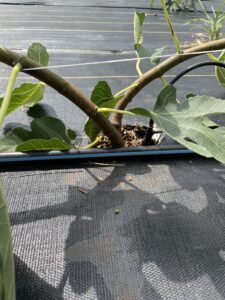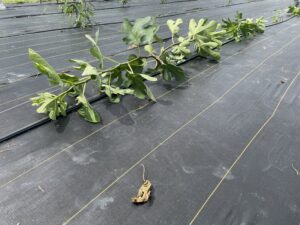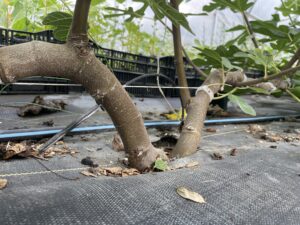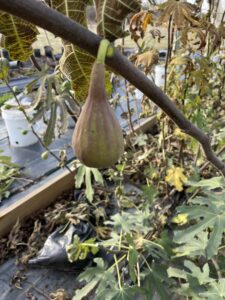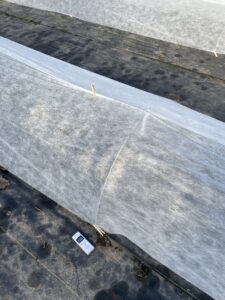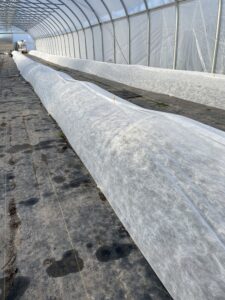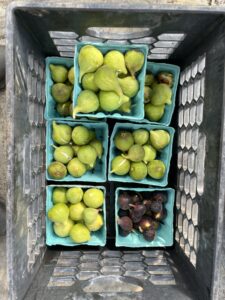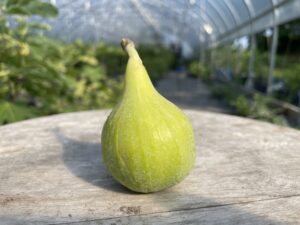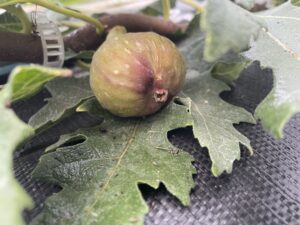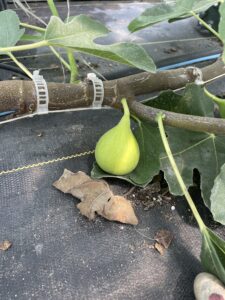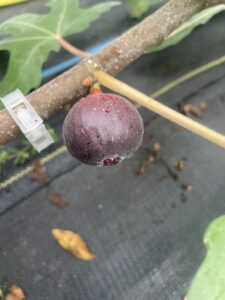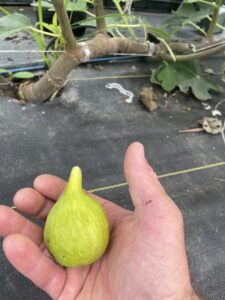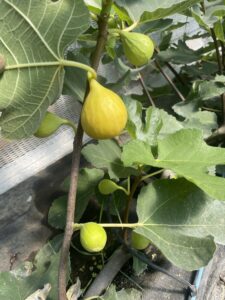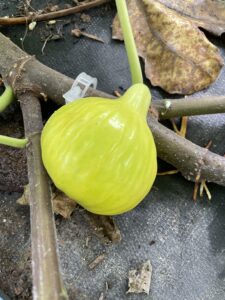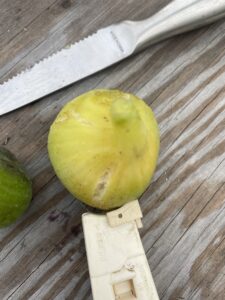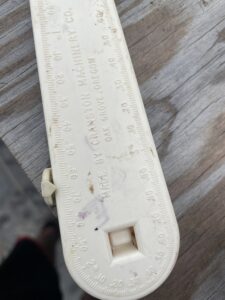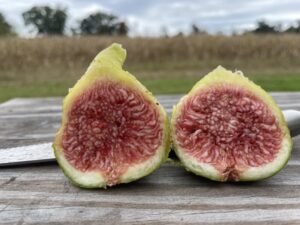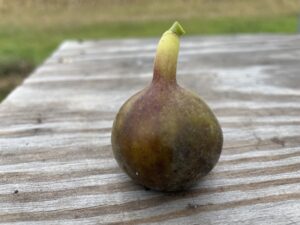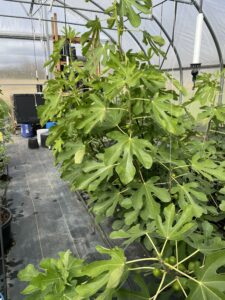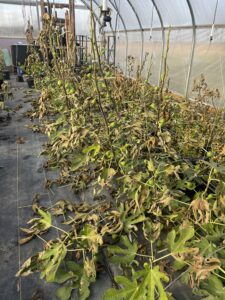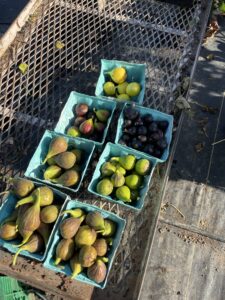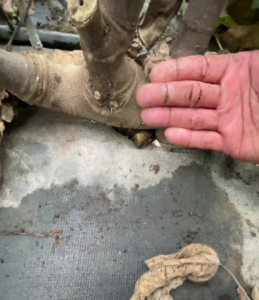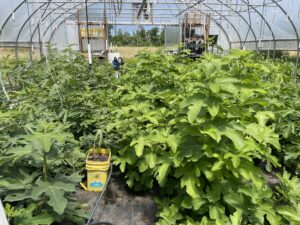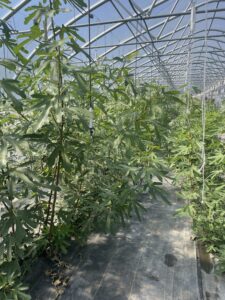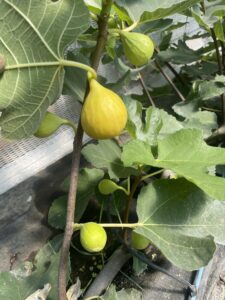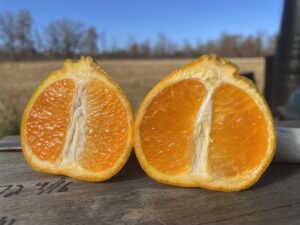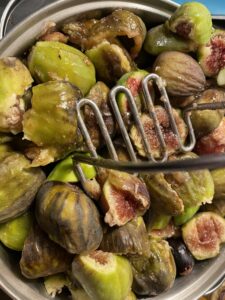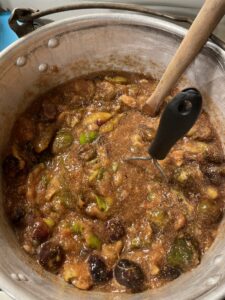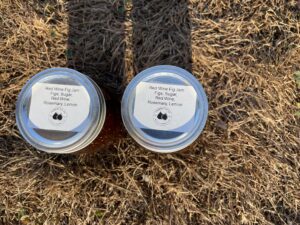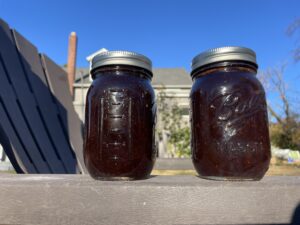Final report for FNE22-003
Project Information
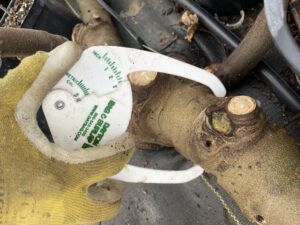
The purpose of the project "Techniques for Growing and Overwintering Japanese Fig Tree Espalier in the Northeast" was to determine if fig trees grown as a Japanese Tree Espalier are a viable fruiting crop for commercial production in the Northeast. Fig trees were trained in high tunnels as cordons directly along the ground using black woven polypropylene fabric ground cover (3.2 oz./sq. yd.). For protection over the winter, the cordons were covered with DeWitt floating row cover (0.55 oz./sq. yd.) suspended with 64" steel wire hoops. Temperatures on the ground under the floating row covered were recorded to be 20°F and 23°F higher than the temperatures on the ground outside in February-March 2024. As a result, buds began to open at the end of February in 2024, which is two months ahead of their open field counterparts. The first fruits were harvested on July 21, 2024, which is approximately 8 weeks ahead of their in-ground counterparts. A harvest of 230 lb was recorded in 2024; this is expected to increase in 2025, as trees continue to mature and set more fruit.
Although the Japanese Fig Tree Espalier method is labor intensive and time consuming in its set-up phase, the benefits of early harvest, ease of winter protection, and pruning simplicity are major assets of the method. We have seen an uptick in home gardeners using the method and as we continue to champion the methods and results, small farmers will increasingly implement the methods not just for figs, but for other subtropical fruit.
This project will contribute to an understanding of whether figs are a viable fruiting crop for retail and wholesale markets for distribution in the Northeast. The main objectives of the project are:
Primary
(1) Establish a fig orchard with low-cordon espalier using the Japanese Stepover method and (2) improve on the results of previous efforts in this area to determine if the above method is viable and scalable for fruit production.
Secondary
(1) Utilize high tunnels to extend the seasons on each end--both spring and fall and (2) use low tunnels with light mulching to further create a microclimate for cordons to survive the winter and consistently produce a fig crop.
My hope is to get one step closer to inaugurating a wave of northeastern commercial fig orchards, bringing this ancient and elusive fruit to our climate so that it can be shared and treasured regardless of socioeconomic status. If successful with figs, other Mediterranean fruits may also be grown similarly on a commercial scale. If we can redefine local as meaning within 50 miles—not 500 miles—I believe we can make the lives of both farmers and consumers more gratifying.
Figs were one of the very first cultivated fruit trees (1). The tree and its fruit (or flower, rather) have inspired stories and cultures in both ancient and modern times. Although figs have been successfully cultivated in the Northeast for many years in backyards both in-ground and pots, commercial fig growing operations do not exist north of the Mason-Dixon line. In fact, California produces 98% of the country's fresh and processed fig fruit (2). How do we build upon the success of backyard fig enthusiasts, who are indeed harvesting fig fruit consistently from pots and in-ground trees throughout the Northeast, and scale that into a commercial operation in which figs are produced, marketed, and sold locally?
I’d like to apply new growing and overwintering techniques to Mediterranean fruit crops, starting with the fig, using high tunnels. If we can learn to produce high-value crops like figs, which are typically grown on the West Coast and shipped across the continent, this will help reduce our carbon footprint. This will also provide more people an opportunity to taste a locally produced, fresh fig versus one that is necessarily harvested early for extended transport. This is at odds with the fig's ephemeral quality; when picked and eaten at its peak of ripeness, it is beloved, and has inspired thousands of backyard growers.
Whereas some have reported success in growing figs and other unique crops like citrus throughout the tri-state area, the larger commercial market is unexplored. The barriers to entry in growing Mediterranean crops are high, and the accessibility of information to enter the market is scarce. If we can develop a more sustainable way to overwinter fig trees in zones 6 and 7, we can bring local fig fruit to retail and wholesale markets in the tri-state area, while minimizing fossil fuel expenditures. This in turn will produce more local jobs and grow the market share directly for figs and other Mediterranean-originated fruit grown and sold in the Northeast.
Historically, the use of heated high tunnels for growing figs has been inefficient. The entire tunnel is typically heated, using natural gas, propane, or fuel oil. This method wastes both energy and space. Fig trees are unique, in that the fruit forms on new growth, not old growth. I propose using the Japanese Stepover Espalier technique (3), in which permanent cordons are established slightly above or at ground level (at ground level, they can be mulched for an extra layer of protection). Once the cordons are established, fruiting branches can be formed every 14 inches along the horizontal growth. These vertical branches are then pruned back every year and new buds emerge the following year, forming new vertical branches on which fruit will form.
To overwinter these cordons, I used Eliot Coleman’s system (4) of floating row covers over the cordons inside the high tunnel. Coleman has used this method for years to grow cold-hardy crops without heat in Maine. According to Coleman, "Double coverage moves the covered area about three USDA zones to the 'south' "(5). During extremely cold nights or weeks, greenhouse plastic could also be added directly on top of this floating row cover. This method allows the soil to store the heat. Coleman commented, “When the outdoor temperature drops to –15˚F (–26˚C), the temperature under the inner layer of the cold house drops only to 15˚F to 18°F above zero (–10˚C to –8°C) on average (5).” Cold-hardy fig trees will suffer no die back until the temperatures are consistently lower than 15˚F. An alternative source of income could be produced while the trees are dormant by planting cold-hardy crops under these row covers.
Citation List
1. Duggan T. Curious about the origin of the fig? Its history is not cut and dried. South Florida Sun-Sentinel August 9, 2001.
https://www.sun-sentinel.com/news/fl-xpm-2001-08-09-0108070377-story.html. Accessed November 11, 2021.
2. Agricultural Marketing Research Center. September 2021. https://www.agmrc.org/commodities-products/fruits/figs. Accessed November 11, 2021.
3. Fig growing in other countries. Growables March 6, 2017 https://www.growables.org/information/TropicalFruit/FigGrowingCountries.htm Accessed November 11, 2021.
4. Culture of edible figs. US Patent Number 7,818,915 B1. US Patent and Trade Office October 26, 2010. https://patentimages.storage.googleapis.com/bf/6a/67/6e76e071c6e7fb/US7818915.pdf Accessed November 12, 2021.
5. Coleman E. The Winter Harvest Handbook: Year-Round Vegetable Production Using Deep-Organic Techniques and Unheated Greenhouses. Chelsea Green Publishing:White River Junction, Vermont. 2009.
I have grown fig trees for retail sale since 2017. More recently, I have entered the wholesale market for fig trees. When I learned that California and Florida were the leading producers of fruit and plants, I decided to make it my mission to bring this specialty crop directly to and from the Northeast market. Currently, I farm part time on 2 acres. My wife and I have 9 children. My oldest children are involved in small tasks like moving plants, placing soil in pots, and planting figs. My high tunnel covers 5,000 square feet. In 2023, my tree sales (including other items like citrus, raspberries, blackberries, pomegranates, guavas, olives, etc.) was $28,000. My total sales for 2024 are expected to be $47,000.
Cooperators
- - Technical Advisor (Educator)
Research
The first step in the process of establishing the Japanese Stepover Espalier was to plant fig trees in the high tunnel. Fig cuttings were started in cells during the winter of 2021 and 2022; the trees were about 1 foot tall when transplanted from their cells in May 2022. At the time of planting, the apical bud was pinched to induce branching. From this branching, two leaders were chosen as the cordons. A piece of wire was run 1 inch above ground over the length of the row, and tomato clips attached the cordon to the wire. Tomato Clips
The selected branches were allowed to grow 2½ feet vertically. Once this growth was established, the lower 6-inch portion was clipped to the guide wire. This allowed the apical buds to continue growing vertically (which is more vigorous than horizontal growth), while slowly training the cordon along the wire. The bottom was trained horizontally biweekly or whenever the horizontal growth was above 2½ feet, encouraging cordon formation horizontally. Leaves were trimmed from the cordon as it was attached to the wire. During this period, the trees were fed fish emulsion, a high nitrogen fertilizer via micro sprinklers.
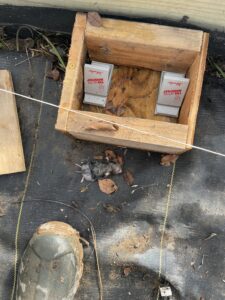
The primary goal in 2022 was to establish healthy cordons and to gain optimal thickness. Thicker, more lignified fig wood survives lower temperatures better than thinner, non-lignified wood (1). To accomplish this, all suckers and fruit were pruned in the first year until the desired length of the cordon was reached. Trees were spaced 7 feet apart in each row, with 6 feet between rows, allowing for 120 trees in the 5,000-square foot high tunnel.
Eliot Coleman–style vole traps (non-baited mouse traps set inside of wooden boxes with small entrance holes) were placed inside and outside the high tunnel in mid-December 2022 (2). Voles can do serious damage to a fruit orchard by girdling the bark and eating through the base of the plant. Vole traps were checked and reset daily through the winter months. These traps alone proved to be enough in deterring voles from entering the high tunnel.
In November 2022, a wireless thermometer and humidity gauge were placed on the ground in the high tunnel. Once nightly high-tunnel temperatures began to dip into the mid-20s for more than an hour or two a night (in 2022, this occurred in mid-December), the low tunnels were deployed by placing 64-inch pre-arched wire hoops over the cordon row and Dewitt AG19 placed over these wire hoops. A second temperature sensor was placed on the ground next to the cordon and a third sensor was placed at the top of the arch inside of the low tunnel. Temperature and humidity from these thermometers were taken and recorded every minute.
A support system for the vertical espalier growth was erected in early 2023. Wires were run above the trusses and connected to the end walls. Two wires were run for each cordon about 4 feet apart. S hooks were attached to the support system. Tomahooks (Tomahooks | Lower & Lean | Johnny's Selected Seeds (johnnyseeds.com) were wrapped with string and used to establish the vertical fruiting branches from the cordon. Starting in the Spring of 2023, buds were allowed to form on the cordon every 14 inches. All other buds were removed at first sight. As buds formed into branches, the branches were trained out from the cordon to allow light and air to reach the center of the cordon. Trellising Vertical Branches
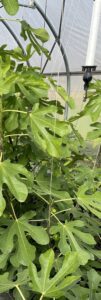
Suckers were pruned from the vertical fruiting branches. The branches were trained with 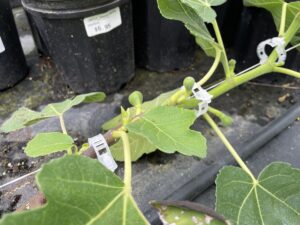 tomato clips weekly. Once fruit began to form, the leaves below the fruit were pruned from the bottom of the plant, moving up as the fruit ripened to improve airflow (like pruning low vegetative growth on greenhouse tomatoes to improve airflow). In early May 2023, the trees were fed with Fertrell Gold Special Starter 2-4-2, which was placed at the base of the trunk under the black woven fabric.
tomato clips weekly. Once fruit began to form, the leaves below the fruit were pruned from the bottom of the plant, moving up as the fruit ripened to improve airflow (like pruning low vegetative growth on greenhouse tomatoes to improve airflow). In early May 2023, the trees were fed with Fertrell Gold Special Starter 2-4-2, which was placed at the base of the trunk under the black woven fabric.
About 90 days is required for figs to progress from embryo formation to ripening. The first fruit for the project ripened from the variety Longue D'Aout on August 16, 2023. The second variety that ripened was Dr. Gowaty on August 21. Ronde de Bordeaux did not begin to ripen until September 21, followed by Teramo on September 30. Golden Riverside began to ripen on October 6, and Atreano and Susser George varieties ripened beginning October 7.
Longue D'Aout produced the largest amount of fruit (55 fruits) and was the most consistent. The others did not produce enough fruit to record. The harvest in 2023 was insufficient to sell, which was disappointing, but my mentor Bill Lauris reminded me that it will take more than one to two years to produce a significant crop.
The trees continued to establish themselves and the cordons continued to thicken, which provided hope and enthusiasm for the 2024 crop. We anticipated that figs might be harvested in the middle of July as opposed to August for 2024.
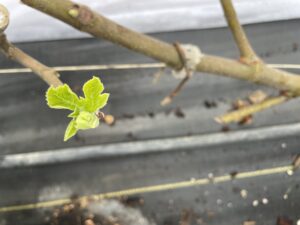
In 2024, the first plant broke dormancy on February 27, which is unheard of in zone 6b. Typical bud break for unprotected, inground trees is late April to early May. Breaking dormancy 2 months earlier supports that not just high tunnels, but low tunnels are a major contributing factor to getting an early start on Mediterranean crops such as figs. If only high tunnels were used, we could expect to see bud break at the beginning of April—certainly not late February to early March.
The first fig was harvested from the variety Doctor Gowaty on July 21. Based on 90 days from fruit formation to harvest, this fig likely formed around April 22, just when unprotected fig trees in the field were beginning to break dormancy. Based upon the 2024 data, we expect the first harvest date to be about 10-14 days earlier in 2025. It should be noted here that low tunnels were employed until about the middle of April. At this point, they do need to be ventilated regularly, or removed as peak temperatures, especially during the days when the sun comes out, can burn the plants.
Although breba were not a focus of this project, it should be noted that they were observed forming on
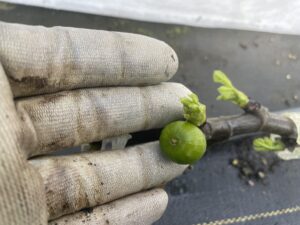
trees on March 10, 2024. Beginning March 2024, the low tunnels were monitored daily. The temperatures in a high tunnel can vary significantly in the Spring. If the sun is out, the tunnel can heat up quite significantly, soaring the temperature under the low tunnels to 120°F at the height of the afternoon. Alternatively, the temperature can drop under these low tunnels to below freezing. We will call this period from March to mid-May the "row cover dance." Temperatures, humidity, and ventilation need to be monitored and adjusted daily. By early June, the doors at either side of the high tunnel are opened almost every day, the fan is consistently running, and the sidewalls were opened to start more meaningful ventilation.
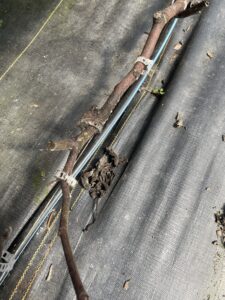
Unfortunately, not everything went exactly as planned in 2024. We left the row cover on our row containing the variety Longue D'Aout into mid-April and the temperatures were hot enough to burn the plants to the ground. While this was disappointing, it was actually an interesting learning experience. One, we did not kill the plants below the ground, so we were given the opportunity to re- establish them. Two, it offered us the opportunity to prove that even having to re-establish the cordon and verticals branches, a harvest of 73 lb was still possible. In short, it is possible for growers in cold climates, who may have winter kill even inside of high tunnels, to still harvest a crop using this method. https://www.youtube.com/watch?v=OOYdSj7GVHo
The total fruit production for 2024 was 230.98 lbs. The most productive varieties were Longue D'Aout, followed by Dr. Gowaty, Ronde de Bordeaux, and Atreano. Pastillier, which is known for dropping fruit, did not produce ripe fruit in 2024. The varieties Teramo, Golden Riverside, Yellow Long Neck, Ventura, and Bronx Special produced the least amount of fruit. It does appear that some varieties perform better growing under low tunnels in high tunnels than others. For example, the Teramo fig typically ripens very early when planted outdoors, but it was not earlier than other varieties in the high tunnel. It was also prone to splitting. Fruit production - 2024
In October 2024, the reverse process of heating the high tunnel was performed. The curtains were rolled up, the doors were closed, and the high tunnel was allowed to heat up during the day. It was a very warm and sunny month (we had a drought during October, as did most of the Northeast). This allowed for an Indian Summer effect in the high tunnel. More fruit began to ripen mid-October after a spell of no fruit at the end of September. They continued to ripen until first frost (a few even ripened after first frost). The vertical branches were pruned in late November and the low tunnels were deployed again.
Citation List
1. Roach, Margaret. How to Grow Figs in a Cold Climate. The New York Times October 6,2021.https://www.nytimes.com/2021/10/06/realestate/how-to-grow-figs-in-a-cold-climate.html Accessed November 11, 2021.
2. Coleman E. The Winter Harvest Handbook: Year-Round Vegetable Production Using Deep-Organic Techniques and Unheated Greenhouses. Chelsea Green Publishing:White River Junction, Vermont. 2009.
The temperature monitoring system was set up in early December of 2023. Five monitoring stations were placed on top of woven landscape fabric in the following areas:
-
- Monitor 1 has been placed on the ground outside of the High Tunnel
- Monitor 2 is connected to the top of the wire hoop inside of the low tunnel.
- Monitor 3 has been placed on the ground inside of the low tunnel.
- Monitor 4 has been placed on the ground, outside of the low tunnel.
- Monitor 5 has been placed on the ground outside of the low tunnel, next to the southern wall of the high tunnel.
The floating row cover produced significant increases in air and soil temperatures inside of the low tunnel in December 2023. The low in December outside of the high tunnel was 4°F on the evening of December 24, while the temperature on the soil inside of the low tunnel that evening was 24°F. The temperature on the ground next to the low tunnel that same evening was 17°F. When the temperature outside rose the following day to 29°F, the temperature on the ground inside the low tunnel was recorded as high as 62°F.
The highest temperature recorded on top of the soil inside of the low tunnel was 87 degrees on December 30. The temperature on the outside of the high tunnel that day was 42 degrees. For comparison, the highest temperature recorded at the top of the low tunnel was 93 degrees on December 30, when the temperature outside was 42 degrees. That is a temperature difference of 51 degrees on a sunny day. None of the fig's cordons were damaged by the low temperatures during the winter of 2022-2023
December Temperature Readings Monitor 1 Outside of High Tunnel Green line is Temperature
December Temperature Readings Monitor 2- Attached to top wire of Floating Row Cover
December Temperature Readings Monitor 3- On Ground inside of Floating Row Cover
December Temperature Readings Monitor 4- On Ground outside of Low Tunnel
The temperatures in January and February of 2023 were comparably moderate. The low for outside of the high tunnel in January was 25°F and 15°F for February. The temperatures inside of the low tunnels did not fall below freezing in the month of January. The temperatures inside the low tunnels only dipped below freezing one time in the month of February. Additionally, by mid-February, the temperatures on the ground in the high tunnel were consistently rising to the 80s and 90s, and even reached to 100°F on a few occasions, with adequate sun. The first recorded bud breaking inside of the high tunnel for 2023 was on March 10. Typical bud break inside of a high tunnel without using low tunnels is the second week of April. This puts fig trees grown as a Japanese espalier under row covers about 4 weeks ahead of those grown only in high tunnels and about 7 to 8 weeks ahead of those grown in the field. This is a significant movement up in bud break and the main reasons that we think we harvested fruit in July 2024.
January Temperature Readings Monitor 1 Outside of High Tunnel
January Temperature Readings Monitor 2- Attached to top wire of Floating Row Cover
January Temperature Readings Monitor 3- On Ground inside of Floating Row Cover
January Temperature Readings Monitor 4- On Ground outside of Low Tunnel
As we moved into March and April, the temperatures in the greenhouse and particularly under the row cover really began to increase. After talking with our mentor Bill, we decided against venting the low tunnels in these early Spring months. Conventional wisdom says to begin venting a low tunnel, or more specifically a greenhouse, when temperatures rise above 90°F. Experts say that plants won't grow above these temperatures. Perhaps that is true for plant growth if these temperatures are sustained for long periods of time. However, the temperatures under the low tunnels went above 120°F and sometimes reached 130 and 140°F during these months, and there was not a single case of a wilting plant or leaf. Figs, and probably other subtropical, Mediterranean, and tropical plants can withstand and even thrive in these temperatures if the humidity stays high. This is an extreme advantage to the Espalier method, because the floating row cover can stay on the Espalier until the fig reaches the height of the row cover.
In 2024 we had the following observations for the months of February- April:
February 2024 - February 2024 Temperature Analysis
- On average, the nighttime low temperature on the ground under the floating row cover was 4.44 degrees higher than the top of the row cover.
- On average, the peak daytime temperature at the top of the floating row cover was 8.86 degrees higher than on the ground.
- On average, the difference between the temperature on the ground outside and under the floating row cover was 20.89 degrees.
- On average, the difference between the temperature on the ground outside and the top of the floating row cover was 29.76 degrees.
March 2024- March 2024 Temperature Analysis
- On average, the nighttime low temperature on the ground under the floating row cover was 4.62 degrees higher than the top of the row cover.
- On average, the peak daytime temperature at the top of the floating row cover was 6.24 degrees higher than on the ground.
- On average, the difference between the temperature on the ground outside and under the floating row cover was 23.91 degrees.
- On average, the difference between the temperature on the ground outside and the top of the floating row cover was 26.7 degrees.
April 2024 (Floating Row Covered Removed) -April Temperature Analysis
- On average, the night-time low temperature on the ground under the floating row cover was 9.5 degrees higher than the top of the row cover.
- On average, the peak daytime temperature at the top of the floating row cover was 18.12 degrees lower than on the ground.
- On average, the difference between the temperature on the ground outside and under the floating row cover was 8.41 degrees.
- On average, the difference between the temperature on the ground outside and the top of the floating row cover was 0.22 degrees.
From our observations, the floating row cover warms the air significantly during the day early in the season (January- March) until the ground warms up in April and May. At that point, the floating row cover and high tunnel have warmed the ground enough to stabilize the temperature of the soil between 40-50°F for the nighttime low. Thus, it is important to get the temperature as high as possible early in the season when temperatures on the ground are still under 40°F.
The purpose of the project "Techniques for Growing and Overwintering Japanese Fig Tree Espalier in the Northeast" was to determine if fig trees grown using the Japanese Stepover Espalier method are a viable commercial crop in the Northeast. The secondary objective was to utilize high tunnels and low tunnels to extend the season and create a microclimate for overwintering the cordons. The results were overwhelmingly positive, and the answer to the above proposed questions is yes. Figs are a viable crop in the Northeast using the Japanese Fig Tree Espalier method.
High tunnels combined with low tunnels extend the season up to two months at the beginning of the season and up to a month at the end of the season. Low tunnel coverings placed over the Japanese Fig Tree Espalier cordon have proven to be a highly successful method for overwintering crops such as fig trees in cold climates.
I will continue to use low tunnels in my high tunnel for years to come. I also believe that utilizing larger low tunnels built with greenhouse plastic and floating row covers implemented for additional protection inside of those tunnels, will become a major low-cost structure on our farm. High tunnels are relatively expensive; low tunnels are a relatively inexpensive way to extend the season not just in the high tunnel but in the open field. These low-cost systems extend the growing season, provide winter protection, and as a result, offer a very high yielding investment.
We plan to implement the Japanese Espalier technique along with low tunnel implementation to explore other Mediterranean and subtropical crops. Citrus is the next on our list along with pomegranates and olives. The sun is a powerful source of energy and even as farmers, we underestimate its strength, even in the winter. Our goal has always been and will continue to be to reduce fossil fuels and deliver high-quality food produced and distributed locally.
Video of figs in high tunnel: https://youtu.be/14nrL-p3oPg
Education & Outreach Activities and Participation Summary
Participation Summary:
In September 2024, we had an opportunity to present our project Techniques for Growing and Overwintering Japanese Fig Tree Espalier in the Northeast at the first-ever Pennsylvania Fig Fest in Pottstown, PA. This was a gathering of about 400 fig enthusiasts all growing in the tri-state area. Our results and findings were presented in a workshop form, with about 50 attendees present.
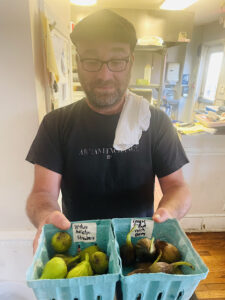
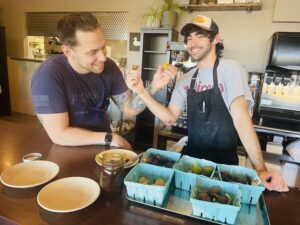
Our love for the fig fruit was shared this fall with local chefs who praised the freshness and quality of our figs over their store-bought counterparts. The response was unanimous in that chefs cannot find locally grown figs for sale. The figs they can find in season are shipped from California and do just not have the flavor or taste, so they never buythem. Interestingly, the chefs each liked different figs. Chef Eric of Charcoal in Yardley liked the variety Yellow Long Neck, nicknaming it the squash fig. Chef Anthony from Trattoria Rosa Bianca in Yardley liked the varieties Ventura and Longue D'Aout. The key takeaway was that different chefs have different palates and tastes.
One of the things we did not expect was the chefs liking our fig jam. Since our production went from a few pounds in 2023 to a few hundred this year, we had an excess of figs some weeks. Some were frozen, others were made into regular fig jam; quite a bit was made into red-wine fig jam. The red-wine fig jam was a real hit with local chefs. They mentioned that its taste and texture was versatile enough to be used both on meats, cheese, and even desserts.
Learning Outcomes

Farmers are starting to realize the benefits of growing inside of low tunnels within high tunnels. For us, the Japanese Fig Espalier awoke in late February 2024. In contrast, the majority of figs planted in the ground in zone 7a and 6b will awaken in early May. The picture of the bud was taken on February 27, 2024. This is at least 8 weeks before in-ground fig trees begin to grow. We believe this head start of 8 weeks will produce significantly higher quality and earlier fruit than their in-ground open-field counterparts.
We also believe that attitudes are changing toward some standard growing practices. During the early months of Spring, temperatures under the low tunnels were reaching 130°F. There was not a single incident of leaf burn or plant die back in 2023. Although greenhouse venting usually begins above 90-100°F, we did not find this necessary until mid-June, when we opened the sides of the high tunnel. We found that figs in particular can withstand the extreme peak temperatures for a few hours a day as long as the humidity stayed high within the tunnel.
Project Outcomes
This project has solidified for me the fact that Mediterranean type plants along with sub-tropical plants respond positively to the average daily temperature over a 24-hour period despite the stark difference between nighttime and daytime extremes.
One of the things this project solidified for me was how much the soil can be warmed by using black woven fabric. Additionally, floating row covers both covering crops and covering bare soil, or in this case black woven fabric, can greatly increase the temperatures inside of high tunnels on a sunny day. This warming effect can benefit the high tunnel year-round, but it is especially important in the months of February, March, and April when Mediterranean crops such as figs are waking up. I hope to see more and more farmers utilizing low tunnels inside of high tunnels to grow a diverse range of crops other than just cold hardy winter greens.
One possible outcome of this project is seeing an increase in numbers of individuals and farmers growing figs inside high tunnels using low tunnels. I would also like to see farmers trying to grow this crop even farther north than Pennsylvania as a single rejuvenated cordon or mulching the cordon yearly. I hope to see a farmer intercropping lettuce, kale, or spinach between the rows of the Japanese Fig Espalier during the winter months for an early Spring harvest.
The project "Techniques for Growing and Overwintering Japanese Fig Tree Espalier in the Northeast" sought to answer the question of whether figs are a viable fruiting crop for retail and wholesale markets for distribution in the Northeast. I believe that the answer to this question is yes. Figs are a viable crop in the Northeast for a number of reasons: (1) The fig has gained considerable attention from the public in recent years and (2) fig trees, especially Japanese Espaliered fig trees can provide multiple streams of income from fresh fruit to cuttings, to leaves dried for tea, and lastly, value-added products like jam and even wine and beer if vintner's and brewers were to buy the fresh or frozen fruit. Two of the most surprising results from our study were the popularity of value-added products like jams and the possibility of selling frozen figs. Personally, I have never seen frozen figs available at the grocery store, yet I think it could be a successful venture if sold to health-conscious people wanting to add frozen fruit to smoothies and post- workout drinks.
Some of the revisions I would make to the parameters of the project are as follows:
- I would use 6-millimeter greenhouse plastic for the low tunnels in the months of December, January, and February. These are the months when the temperatures drop drastically at night and while I don't think the Japanese Fig Tree Espalier need extra protection for winter survival (at least in Pennsylvania) above the floating row cover, I do postulate that the figs may wake up even earlier in February by driving the daytime temperatures even higher while the trees are dormant. I would then switch to the floating row cover in March and April.
- I would consider adding a ventilation component, using small fans in the low tunnels during the months of March and April. Although most high tunnels have fans for ventilation, this is not generally the case for low tunnels. These would be simple, low-voltage fans that would help regulate the temperature under the low tunnels by allowing excess heat to be released into the high tunnel. The larger fan would still control the overall temperature of the high tunnel, allowing for this excess heat from the low tunnels to not just be released out of the tunnel.
- I would recommend closing the high tunnel much sooner than I did in the fall. It was a very hot summer and fall for us in Pennsylvania during 2024, so the inclination was to keep the high tunnel sides and doors open longer. However, I would recommend closing the tunnel in early to mid-September. We noticed an uptick in fruit ripening and even unexpected growth on the fig trees once the tunnel was closed back up in early October. If we had closed the doors sooner, I believe a third crop may have begun to ripen from the Espalier.
I definitely plan to promote and become a champion of the Japanese Fig Tree Espalier approach in the future. I also believe other sub-tropical and tropical plants will benefit from this method. My next planned crop is citrus, followed by pomegranates. From our observations, the hotter the specific species likes the temperature, the more explicit the response from elevated daytime temperatures. Our observations also indicate that younger, more immature plants and plant growth respond rapidly to peak daytime temperatures, while older, woodier trees are less tolerant of significant temperature swings on the high end of the spectrum.
The following questions would benefit from further research in this area of Japanese Fig and Plant Tree Espalier:
- What is the maximum temperature per plant species under the low tunnels, and how long can these temperatures be maintained?
- What is the correlation between air temperature and ground temperature under the low tunnels? Does the air temperature matter or should we really be concerned about the ground temperature? (From what we can tell, leaving ground uncovered by low tunnels is a disadvantage to the system as any covering, not just coverings over plants, better maintain temperatures in the high tunnel in late winter and early spring).
- How long can peak temperatures be maintained before the low tunnels must be vented and does month of the year have an effect on length of peak temperatures and potential plant damage. i.e. higher and more sustained temperatures in February are not as concerning as they are in May because the plants are still dormant in February.
- Could figs still be a viable crop as far north as Vermont, Maine, and even Canada if they were winter killed to the crown every year and Re- Espaliered in the late winter or early spring? Row covers could be maintained for longer periods into the Spring, and plants could be spaced more densely to increase yields.
I think the groups of people that would benefit most from the above results are small farmers with 2-50 acres as well as owners of CSAs. These farmers are looking for a viable fruiting crop that could differentiate them from the competition and bring in more members.
Revisions
One of the things I would do differently when planting the figs is to hill the rows where the figs were planted. I would do this because our soil can be quite wet, even during the dry months, and this slight ridging would help keep the base of the figs dry. I would also grow the cordon slightly higher off the ground, probably 2-3 inches above ground level. The reason for this is that any figs that form along the cordon may touch the ground, and if the humidity is high during the time they're ripening, they will rot if they are touching the woven landscape fabric. One of the changes I made from the original proposal was the choice to not mulch the cordons. I did this because I wanted to determine if the figs would survive without this extra protection. So far, this has been the case. I propose that orchards farther north employ mulching as an extra preventive measure.
Another change I would make is planting figs from quarts or gallons. Planting from cells proved to be too small, and we had to baby some of the plants through the first year. Since these plants would be farther along in the process, I would prune the apical bud in the pots so that low branches would form allowing the espalier to be partly established at the time of planting rather than afterwards.
One of the possibilities I see with protecting the Japanese Fig Espalier with floating row covers, particularly for shorter season climates, is growing the Espalier not as verticals, but merely as single cordons each year. In places where one might not be able to protect the cordon for winter survival, I believe one could grow new fruiting cordons each year. The cold hardiest figs will sprout new growth from the base if they die to the ground. The advantage to growing new cordons yearly would be the ability to keep the floating row cover on during the spring and early summer. During the height of the summer, the cover could be removed, but added back on in the fall for additional ripening time. In this way, the high tunnel could be densely planted because not as much space would be need per plant since the cordons would die to the ground yearly.
